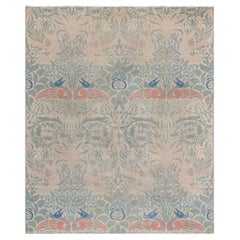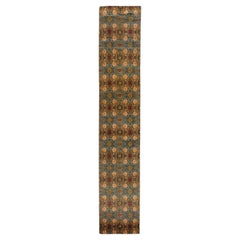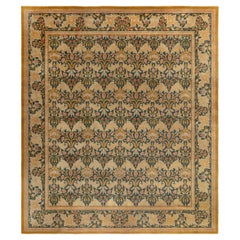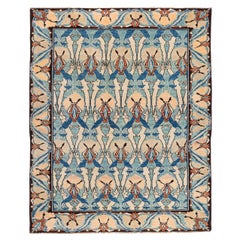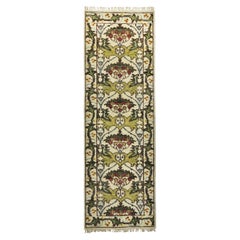William Morris (English) Western European Rugs
4
to
3
1
4
4
4
4
1
3
3
Width
to
Length
to
4
4
4
4
3
8
508
480
315
195
Creator: William Morris (English)
1900s William Morris Textile
By William Morris (English)
Located in New York, NY
1900s William Morris Textile
Size: 5'4" × 6'5" (162 × 195 cm)
Category
Early 20th Century English Arts and Crafts William Morris (English) Western European Rugs
Materials
Wool
1900s William Morris Botanic Fragment Runner
By William Morris (English)
Located in New York, NY
Authentic 1900s William Morris botanic Fragment Runner
Size: 3'6" × 22'7" (106 × 688 cm)
This outstanding runner was created by the icon of Arts and Crafts rugs sale textile design, ...
Category
Early 20th Century British Arts and Crafts William Morris (English) Western European Rugs
Materials
Wool
William Morris machine made English carpet Circa 1920
By William Morris (English)
Located in New York, NY
William Morris machine made English carpet Circa 1920
Size: 12'7" × 14'1" (383 × 429 cm)
A second quarter 20th century English carpet in the style of William Morris in the famous tulip design on a greenish-blue field and border and stylized flowers in yellows, beiges, greens, and pinks.
Although developed at the beginning of the 20th century, Arts and Crafts carpets are absolutely applicable in contemporary interiors. It can be attributed to their balanced and utterly tasteful designs which have the power of transcending time and ever-changing fashions. This is why, an arts and crafts vintage...
Category
Early 20th Century English Arts and Crafts William Morris (English) Western European Rugs
Materials
Wool
Morris & Co. Possibly Made by J.R. Burrows & Co., America Four Lengths of Carpet
By William Morris (English)
Located in London, GB
Morris & Co. possibly made by J.R. Burrows & Co. in America.
Four lengths of carpet made for hallway, staircase or walkway runners.
Measures:
Width of all four carpets are 26.75 i...
Category
1880s English Arts and Crafts Antique William Morris (English) Western European Rugs
Materials
Wool
Related Items
Ararat Rugs William Morris Style Carpet Arts & Crafts Design Natural Dyed
By Ararat Rugs
Located in Tokyo, JP
The source of carpet comes from the book Arts & Crafts Carpets, by Malcolm Haslam, and David Black, in 1991. This carpet is interpreted by our designers with William Morris designs in the 1880s – in the United Kingdom. In 1887 English artist and bookbinder T.J. Cobden Sanderson, suggested that a new group be named the “Arts and Crafts Exhibition Society” As a result, he was the first to use the term “Art and Crafts” and also is credited with naming this new emerging movement. The Arts & Crafts movement was inspired by the degradation of product standards that resulted from the factory production age. The rise of machinery in manufacturing caused a noticeable decline in uniqueness and crafts. These anti-industrial reformers promoted economic advancement and social change. They wanted to eliminate poor quality and “artificial” items from 19th-century British society. They saw a plethora of uninteresting items on display at the Great Exhibition of 1851 and became inspired to launch a campaign for originality and uniqueness.
William Morris was an English designer, as well as an uplifting social activist and writer. Morris is credited with sparking the rebirth of textile arts and traditional means of production. In 1861, Morris and a small group of designers opened an incredibly fashionable design company that grew to be largely successful. Morris left behind works in many different mediums such as textiles, books, furniture, stained glass, and area rugs. But in the end, he is most remembered for the magnificent wallpapers that he designed. He got much of his inspiration from the natural world. Through his interior decor pieces, Morris set out to convert rooms or spaces into meadows with beautiful trees meandering, vines, and plants. This concept of taking something industrial and man-made, and converting it into something natural is what William Morris meant when he once said: “-any decoration is futile… when it does not remind you of something beyond itself.”
Morris was a huge commercial success and his works are some of the most sought-after pieces in the world of design and decor. He is also credited with almost single-handedly reviving the British textile arts as well as their methods of production. Morris was also severely critical of machine-made goods, exclaiming, “Today almost all wares that are made by civilized man are shabbily and pretentiously ugly.” Houses were filled “with tons and tons of unutterable rubbish,” which, he suggested, should be heaped onto a gigantic bonfire! “As a condition of life, production by machinery is altogether evil.” He masterminded one of the most well-known styles of Arts & Crafts, recognizable by its twisting and arching patterns and simple, elegant floral design prints. Although Morris believed that Persian carpets were the greatest ever made, he adopted the coarser Turkish (Ghiordes) knot for his hand-knotted carpet manufacture. They were woven at a thickness of 25 knots to the square inch at that time. Morris & Co.’s rugs are reminiscent of Persian garden design carpets in that they are smartly styled depictions of English gardens. Donegal also started producing highly desirable Irish rugs in the late 19th century. The Donegal rugs were predominantly created by English architects C.F.A. Voysey and Gavin Morton. The hand-crafted Voysey rugs are typically woven in England, Scotland, and Ireland. Voysey had a knack for using contrasting shapes to decorate flat monochromatic spaces. Dark outlines added a flair of drama to his signature pattern and Celtic rug...
Category
21st Century and Contemporary Turkish Arts and Crafts William Morris (English) Western European Rugs
Materials
Wool, Organic Material, Natural Fiber
Free Shipping
W 61.03 in L 74.02 in
Ivory William Morris Inspired Runner
Located in Laguna Hills, CA
hand knotted, wool pile on a cotton foundation.
2'8" x 8'
New
Origin: India
Field Color: Ivory
Border Color: Ivory
Accent Color: Light-Green, Dark-Green, Gold, Brow...
Category
2010s Indian Arts and Crafts William Morris (English) Western European Rugs
Materials
Wool
Ararat Rugs the Fintona William Morris Carpet, Arts and Crafts, Natural Dyed Rug
By Ararat Rugs
Located in Tokyo, JP
The source of the carpet comes from the book Arts & Crafts Carpets, by Malcolm Haslam, and David Black, 1991, fig.55. This Donegal carpet was possibly designed by the Silver Studio for Liberty’s c.1902, United Kingdom. In 1887 English artist and bookbinder T.J. Cobden Sanderson, suggested that a new group be named the “Arts and Crafts Exhibition Society” As a result, he was the first to use the term “Art and Crafts” and also is credited with naming this new emerging movement. The Arts & Crafts movement was inspired by the degradation of product standards that resulted from the factory production age. The rise of machinery in manufacturing caused a noticeable decline in uniqueness and crafts. These anti-industrial reformers promoted economic advancement and social change. They wanted to eliminate poor quality and “artificial” items from 19th-century British society. They saw a plethora of uninteresting items on display at the Great Exhibition of 1851 and became inspired to launch a campaign for originality and uniqueness.
William Morris was an English designer, as well as an uplifting social activist and writer. Morris is credited with sparking the rebirth of textile arts and traditional means of production. In 1861, Morris and a small group of designers opened an incredibly fashionable design company that grew to be largely successful. Morris left behind works in many different mediums such as textiles, books, furniture, stained glass, and area rugs. But in the end, he is most remembered for the magnificent wallpapers that he designed. He got much of his inspiration from the natural world. Through his interior decor pieces, Morris set out to convert rooms or spaces into meadows with beautiful trees meandering, vines, and plants. This concept of taking something industrial and man-made, and converting it into something natural is what William Morris meant when he once said: “-any decoration is futile… when it does not remind you of something beyond itself.”
Morris was a huge commercial success and his works are some of the most sought-after pieces in the world of design and decor. He is also credited with almost single-handedly reviving the British textile arts as well as their methods of production. Morris was also severely critical of machine-made goods, exclaiming, “Today almost all wares that are made by civilized man are shabbily and pretentiously ugly.” Houses were filled “with tons and tons of unutterable rubbish,” which, he suggested, should be heaped onto a gigantic bonfire! “As a condition of life, production by machinery is altogether evil.” He masterminded one of the most well-known styles of Arts & Crafts, recognizable by its twisting and arching patterns and simple, elegant floral design prints. Although Morris believed that Persian carpets were the greatest ever made, he adopted the coarser Turkish (Ghiordes) knot for his own hand-knotted carpet manufacture. They were woven at a thickness of 25 knots to the square inch at that time. Morris & Co.’s rugs are reminiscent of Persian garden design carpets in that they are smartly styled depictions of English gardens. Donegal also started producing highly desirable Irish rugs in the late 19th century. The Donegal rugs were predominantly created by English architects C.F.A. Voysey and Gavin Morton. The hand-crafted Voysey rugs are typically woven in England, Scotland, and Ireland. Voysey had a knack for using contrasting shapes to decorate flat monochromatic spaces. Dark outlines added a flair of drama to his signature pattern and Celtic rug...
Category
21st Century and Contemporary Turkish Arts and Crafts William Morris (English) Western European Rugs
Materials
Wool, Organic Material, Natural Fiber
Free Shipping
W 55.12 in L 60.63 in
Modern Wool Rug Carpet Made in Spain Blue and Red Nudity by Coco Davez
By Coco Davez
Located in Madrid, ES
This rug has been designed by Coco Davez, Spanish artist who develops her career in different fields, painting, photography or art direction. The nude colle...
Category
21st Century and Contemporary Spanish Modern William Morris (English) Western European Rugs
Materials
Wool
Modern Hand Tufted Wool Rug Carpet Made in Spain Green Brown White Leaves
By Kilombo Home
Located in Madrid, ES
This rug is handmade in Spain using the hand tufted technique.
We use only the finest natural yarns, 100% pure virgin wool with a thickness of 15mm.
- Customize in any size and in ...
Category
21st Century and Contemporary Spanish Modern William Morris (English) Western European Rugs
Materials
Wool
Vintage Indian Rug with Arts & Crafts Style Inspired by William Morris
By William Morris (English)
Located in Dallas, TX
77517, vintage Indian rug with Arts & Crafts style inspired by William Morris. The architectural elements of naturalistic forms combined with Arts & Crafts style, this hand knotted w...
Category
Mid-20th Century Indian Arts and Crafts William Morris (English) Western European Rugs
Materials
Wool
Late 19th Century English William Morris Large Leaf Verdure Tapestry
By William Morris (English)
Located in New York, NY
An English William Morris verdure tapestry from the turn of the 20th century, featuring several peacocks within a verdant setting of large leaves and floral sprays. Enclosed within a...
Category
Early 20th Century English Art Deco William Morris (English) Western European Rugs
Materials
Wool
Ararat Rugs Holland Park William Morris Carpet, Arts and Crafts, Natural Dyed
By Ararat Rugs
Located in Tokyo, JP
The source of carpet comes from the book Arts & Crafts Carpets, by Malcolm Haslam, and David Black, 1991, fig.49. This Hammersmith carpet was designed by William Morris in 1882, in the United Kingdom. In 1887 English artist and bookbinder T.J. Cobden Sanderson, suggested that a new group be named the “Arts and Crafts Exhibition Society” As a result, he was the first to use the term “Art and Crafts” and also is credited with naming this new emerging movement. The Arts & Crafts movement was inspired by the degradation of product standards that resulted from the factory production age. The rise of machinery in manufacturing caused a noticeable decline in uniqueness and crafts. These anti-Industrial reformers promoted economic advancement and social change. They wanted to eliminate poor quality and “artificial” items from 19th century British society. They saw a plethora of uninteresting items on display at the Great Exhibition of 1851 and became inspired to launch a Campaign for originality and uniqueness.
William Morris was an English designer, as well as an uplifting social activist and writer. Morris is credited with sparking the rebirth of textile arts and traditional means of production. In 1861, Morris and a small group of designers opened an incredibly fashionable design company that grew to be largely successful. Morris left behind works in many different mediums such as textiles, books, furniture, stained glass, and area rugs. But in the end, he is most remembered for the magnificent wallpapers that he designed. He got much of his inspiration from the natural world. Through his interior decor pieces, Morris set out to convert rooms or spaces into meadows with beautiful trees meandering, vines, and plants. This concept of taking something Industrial and man-made, and converting it into something natural is what William Morris meant when he once said: “-any decoration is futile… when it does not remind you of something beyond itself.”
Morris was a huge commercial success and his works are some of the most sought-after pieces in the world of design and decor. He is also credited with almost single-handedly reviving the British textile arts as well as their methods of production. Morris was also severely critical of machine-made goods, exclaiming, “Today almost all wares that are made by civilized man are shabbily and pretentiously ugly.” Houses were filled “with tons and tons of unutterable rubbish,” which, he suggested, should be heaped onto a gigantic bonfire! “As a condition of life, production by machinery is altogether evil.” He masterminded one of the most well-known styles of Arts & Crafts, recognizable by its twisting and arching patterns and simple, elegant floral design prints. Although Morris believed that Persian carpets were the greatest ever made, he adopted the coarser Turkish (Ghiordes) knot for his hand knotted carpet manufacture. They were woven at a thickness of 25 knots to the square inch at that time. Morris & Co.’s rugs are reminiscent of Persian garden design carpets in that they are smartly styled depictions of English gardens. Donegal also started producing highly desirable Irish rugs in the late 19th century. The Donegal rugs were predominantly created by English architects C.F.A. Voysey and Gavin Morton. The handcrafted Voysey rugs are typically woven in England, Scotland, and Ireland. Voysey had a knack for using contrasting shapes to decorate flat monochromatic spaces. Dark outlines added a flair of drama to his signature pattern and Celtic rug...
Category
21st Century and Contemporary Turkish Arts and Crafts William Morris (English) Western European Rugs
Materials
Wool, Natural Fiber, Organic Material
Free Shipping
W 68.9 in L 118.9 in
1900s Antique Bessarabian Floral Runner - 12'10'' X 5'2''
Located in Los Angeles, US
Antique Bessarabian Rugs / Kilims in both pile and tapestry weaving technique are some of the more beautiful carpets to have been produced in Europe. Many of the Bessarabian Kilims w...
Category
1910s European Bessarabian Vintage William Morris (English) Western European Rugs
Materials
Wool, Cotton
Vintage European Carpet
Located in New York, NY
Worn mid-20th century European carpet with a matching floral field and motif in dominant green and pink shades.
Measures: 9'10'' x 13'.
Category
20th Century Bulgarian Bessarabian William Morris (English) Western European Rugs
Materials
Wool
Art Deco Savonnerie Carpet, 1920s
Located in New York, NY
Art Deco Savonnerie carpet, 1920s
France, circa 1920-1930.
Category
1920s French Art Deco Vintage William Morris (English) Western European Rugs
Materials
Wool
Art Deco Savonnerie Carpet, 1920
Located in New York, NY
Art Deco Savonnerie Carpet, 1920
France, circa 1920.
Category
Early 20th Century French Art Deco William Morris (English) Western European Rugs
Materials
Wool
Previously Available Items
William Morris Runner Fragment
By William Morris (English)
Located in New York, NY
William Morris runner fragment
Size: 4'3" × 23'0" (129 × 701 cm)
This outstanding carpet runner was created by the icon of Arts & Crafts rug te...
Category
Early 20th Century British Arts and Crafts William Morris (English) Western European Rugs
Materials
Wool
William Morris Runner Fragment
By William Morris (English)
Located in New York, NY
A William Morris fragment runner, circa 1900. This mesmerizing and imposing Arts & Crafts runner proudly bears an all-over, repetitive botanical design of meandering vines which form...
Category
Early 20th Century English Arts and Crafts William Morris (English) Western European Rugs
Materials
Wool
Vintage William Morris Rug
By William Morris (English)
Located in New York, NY
Vintage William Morris Rug
Category
Mid-20th Century English Mid-Century Modern William Morris (English) Western European Rugs
Materials
Wool
William Morris (english) western european rugs for sale on 1stDibs.
William Morris (English) western european rugs are available for sale on 1stDibs. These distinctive items are frequently made of wool and are designed with extraordinary care. There are many options to choose from in our collection of William Morris (English) western european rugs, although orange editions of this piece are particularly popular. Many of the original western european rugs by William Morris (English) were created in the Arts and Crafts style in united kingdom during the early 20th century. If you’re looking for additional options, many customers also consider western european rugs by and Gavin Morton. Prices for William Morris (English) western european rugs can differ depending upon size, time period and other attributes — on 1stDibs, these items begin at $4,707 and can go as high as $16,000, while a piece like these, on average, fetch $10,354.
Questions About William Morris (English) Western European Rugs
- What was William Morris' style?1 Answer1stDibs ExpertFebruary 13, 2024William Morris's style was Arts and Crafts. In fact, the designer was responsible for helping to define and develop the style. The history of Arts and Crafts design has roots in 1860s England, with an emphasis on natural motifs and simple flourishes. Morris became known for reviving historical techniques such as embroidery and printed fabrics in his furnishings and influenced American Arts and Crafts designers like Gustav Stickley. Shop a selection of William Morris furniture on 1stDibs.
- 1stDibs ExpertApril 5, 2022Yes. William Morris is one of the most prolific textile designers, and was the founder of the Arts and Crafts movement of the late 1800s. His designs incorporated elaborate floral motifs of silk and linen embroidery. On 1stDibs, shop a selection of items with William Morris’ iconic designs from some of the top sellers around the world.
- 1stDibs ExpertApril 5, 2022Yes, William Morris made furniture. While William Morris is best known for being a textile designer, poet and artist, he also designed furniture. William Morris’s furniture was inspired by nature and his belief in socialism, with designs focused on creating affordable and long-lasting furniture that everyone could enjoy. Shop a selection of William Morris furniture on 1stDibs.
- 1stDibs ExpertApril 5, 2022Yes, William Morris made some tapestries. William Morris was a true artisan and delved into a variety of different areas. He’s also credited with ushering in the Arts and Crafts movement in England. He held a lot of respect for those who could produce tapestries and made his first one in 1879. He learned more and created more tapestries but also established a small tapestry workshop where he employed tapestry weavers. Shop a collection of tapestries from some of the world’s top sellers on 1stDibs.
- 1stDibs ExpertApril 5, 2022William Morris used a variety of fabrics to produce wallpaper, floor coverings and other textiles. However, cotton and linen were the most common materials. His workshop became known for producing intricate hand-blocked prints on textiles. Find a variety of William Morris rugs and textiles on 1stDibs.
- 1stDibs ExpertFebruary 7, 2024Which William Morris designs are the most famous is open for debate. However, some patterns of William Morris wallpaper have consistently remained in style since their debut in the 19th century. They include Larkspur, Jasmine, Marigold, Wreath, Willow Boughs, Acanthus, Strawberry Thief and Chrysanthemum. On 1stDibs, shop a collection of William Morris furniture and decorative objects.
